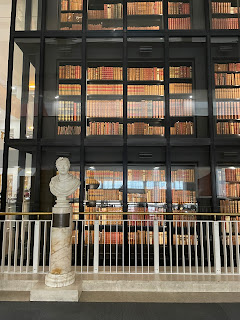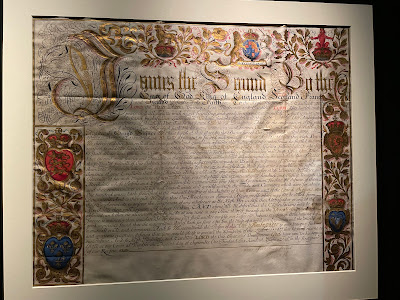 |
| Hello, George III! |
 |
| Letter from James II to the Ottoman Empire (1685) |
 |
| This is a Haggadah showing pictures from the Book of Genesis |
 |
| Dr. Steele |
 |
| Vivien Leigh as Lady Macbeth |
 |
| I recommend a trip to Shakespeare's Globe! |
 |
| Hello, George III! |
 |
| Letter from James II to the Ottoman Empire (1685) |
 |
| This is a Haggadah showing pictures from the Book of Genesis |
 |
| Dr. Steele |
 |
| Vivien Leigh as Lady Macbeth |
 |
| I recommend a trip to Shakespeare's Globe! |
How lovely! I've been to a university alumni event at the Globe (decades ago) but have never seen a play there.
ReplyDeleteAnother book blogger (Jenny at Reading the End) had told me it was fun to be a groundling, so we tried it for the second of two shows last time we got to go to the Globe. At the first show, Dr. Faustus, there was a lot of action in the standing crowd (at one point Faustus threw a "tongue" so one of the groundlings could catch it). At the second, the one we stood for, there were only entrances and exits. So you never know.
ReplyDeleteWill I ever visit England again? Seeing Twelfth Night at the Globe was a highlight of my travels in my journeyman years ... I'd love to see something else. For Lear, though, I would definitely want a seat, not standing room. Sorry about the problems at the British Library but the exhibits you got to see sound amazing.
ReplyDeleteOf course, you will, Lory! And the least expensive times to go are in the winter so it is not impossible, just might not happen right away.
ReplyDeleteI have done standing room at the Met in New York and at the ART in Cambridge, MA and it is more civilized there (at the Met, you get an assigned standing place with room to lean). Someone told us the next day that the clever thing to do is buy one seat and one standing room ticket and switch at the interval. I guess that would work because some people simply left at the interval so it might not be too hard to wiggle into a place where one can see. But we got there in time to stand quite near the front. I had to tell a Greek woman that she could not block our view by filming the whole time (ironic that an usher came and scolded us for sitting for a few minutes but ignored all the people taking unauthorized photos and filming).
Jeanne, apparently the crowd participation really depends on the mood and personality of the audience.